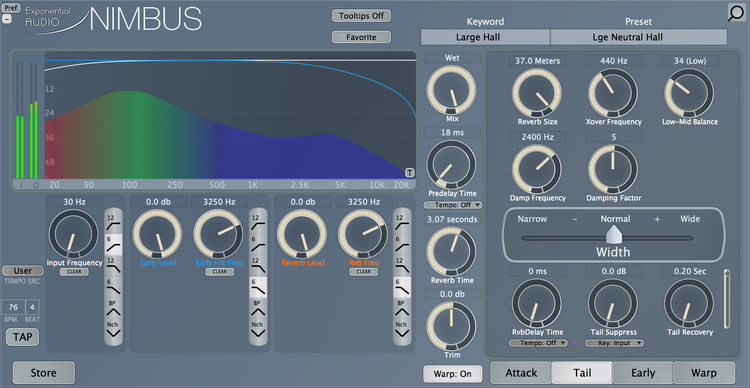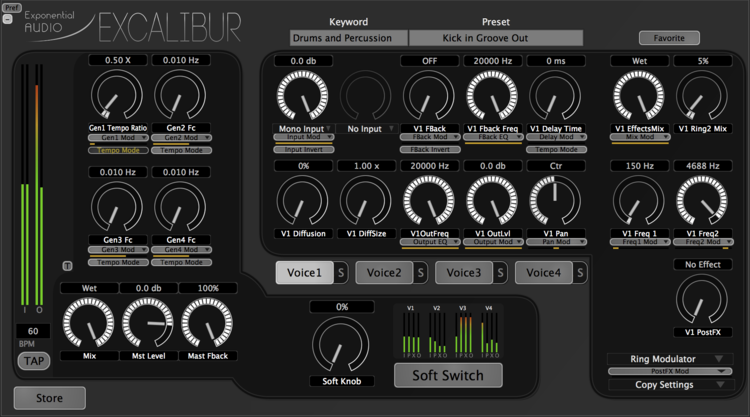Exponential Audio’s Michael Carnes on Making Great Reverbs
Digital reverb plugins: We love them, we hate them. During the onset of the DAW revolution, I mostly ignored them. But just as time heals all wounds, it has also helped computers process the complexity of reverb.

Exponential Audio makes high-quality algorithmic reverbs in the age of convolution reverbs. Read on for why algorithmic reverbs still matter, and fill niches that impulse response reverbs just can’t.
One company at the forefront of harnessing computers to make beautiful spaces is Exponential Audio.
I sat down with Michael Carnes, a classical musician, recording engineer and founder of the company, to tell us more about his process, his plugins and the state of digital reverb
Could you give us a little background history of digital reverb and how reverb plugins like yours fit into it?
There are some landmark hardware reverbs, starting with the EMT 250 and proceeding through the Lexicon 224 and 480L. Later developments included products like the TC6000 and the Lexicon 960L. The most recent hardware devices would include the Bricasti M7 and the Lexicon PCM96. It’s my personal feeling that, while you might see another device or two, it may be the end of the line for high-quality standalone reverbs.
The development of high-quality reverb plugins was initially hampered by the processors in personal computers, but those computers have long since been far more powerful that the processors in standalone boxes.
We probably started to turn the corner eight or nine years ago. At every step along the way, developers have found clever ways to get the most out of the processing power available.
What are your favorite analog sources of reverb?
Real places of course. There was nothing like the sound of the old Jordan Hall in Boston. It’s been remodeled and still sounds great, but I preferred it before.
I’ve always liked good chambers and have been fortunate enough to tour some of the best.
And then there are fascinating odd places, like a sand-filled sea cave on the north side of Kaui. You can’t quite stand up in it, but it extends a couple of hundred feet around. It’s a very strange sound.
Do you ever model your reverbs on real spaces, or are these entirely algorithmic?
The two aren’t mutually exclusive. There’s the strict kind of modeling that involves taking an impulse response and then convolving a signal with it. That’s never been particularly attractive to me. I’m more interested in making algorithms that work in more fundamental ways and have the flexibility to solve problems of the specific mix where they’re being used.
While there’s some adjustability in convolution reverbs, each impulse response is basically what it is. For example, if the low reverb time is too long, you generally have to go looking for another impulse response.
In an algorithmic reverb, you can adjust that (or any other value) to get just what you need. And in most cases you can do it on the fly–while audio is passing.
An algorithmic reverb usually doesn’t have the pretty pictures that come with a convolver, but it’s a more flexible and powerful tool when it comes to really making a mix. On top of that, a well-designed algorithmic reverb is considerably easier on the CPU with a much lower latency.
How did you learn to listen for the nuances of reverb?
I’ve been in a lot of halls and recital spaces, some purely as a listener, some as a recording engineer, and even a few as a performer. The response of the room has a huge effect on the ability of the performers to do their best and it also dictates how well listeners can discern what’s going on.
A bad room can undermine even the best performance, whereas a good room can make a good performance into a transcendent experience. I can’t enter a performance space without doing a mental evaluation of the nature of the room. That extends to other kinds of spaces as well—forests, canyons and so on.
I’ve noticed a lot of presets with each one of your plugins—what kind of workflow lead to this?
One of the things you learn after some time in this business is that users rarely have the time or inclination to program reverb for themselves. So it’s important to provide a lot of options, organized in such a way that they can quickly audition presets and get close to what they need. They may need to do minor tweaks, so make sure those necessary controls are front and center.
All of my preset organization—keywords, favorites, search—is based on getting to a solution quickly. Anybody who mixes for a living is under tremendous time pressure, so any way a developer can help will be appreciated.
Regarding DSP usage, your plugins seem to be really lean. I know because my computer is 10 years old and can still load multiple instances of even your latest plugins. How do you pull that off?
I’ve been programming computers for 40 years. As you might imagine, computers haven’t always been as powerful as they are now. That sort of experience helps to breed an efficiency mindset.
Also, knowing how the underlying hardware actually works is hugely important. There might be two ways to solve a problem and they might look very similar. But one of those solutions could be a lot more efficient. It’s all about knowing how to sort that out.
Have you ever put your reverb into a hardware or considered doing so?
I’ve often been asked about it. But in order to do that you have to build a different kind of company.
You need a hardware designer and an industrial designer. You’ll need additional programmers and you have to deal with regulatory issues, like UL, FCC and CE. You’ve got to rent lab space and you have to deal with inventory, packaging and potential disposal of hazardous waste.
I was in that world for a long time, and I’m perfectly happy not to be in that world now.
Have you ever thought about making other effects?
Have you missed Excalibur? [Author’s note: Yes]
It’s Exponential Audio’s delay/FX plugin and includes flange, chorus, pitch shift, distortion, resonators and several other effects. It’s been out for a few years now.
As far as reverb goes, it’s something I know and something I listen for. It’s among the most important tools to make a good recording, and I’m always thinking of ways to improve it.
Where do you think we are at now in terms of audio quality, and where are we heading?
Quality will continue to improve as long as there are talented designers with a passion for audio. I’m looking forward to hearing what might happen.
Will analog forms of reverb ever be obsolete?
I sure hope not. Our world is getting louder in many ways and it’s harder to find a good place to listen that isn’t affected by traffic or some other racket. There’s still nothing like listening to pure unamplified music in a real place.
Your future plans?
A little sleep would be nice…
Please note: When you buy products through links on this page, we may earn an affiliate commission.








